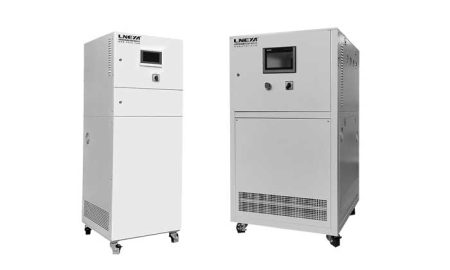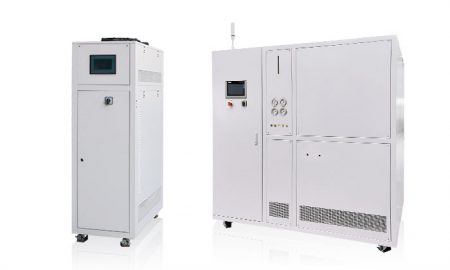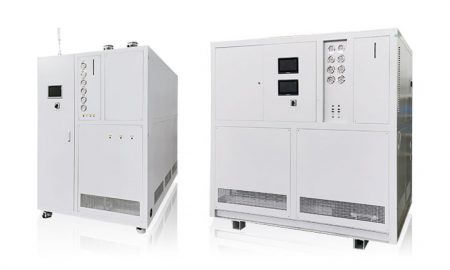Electric Vehicle Cooling Heating Overall Optimization Battery Cooling
Contattateci oggi stesso per la soluzione di controllo della temperatura perfetta
With the energy crisis, environmental protection requirements and automobile emission regulations becoming increasingly stringent, the optimization of automobile thermal management systems has received increasing attention. Integrating various systems or components of the car, such as the cooling system, lubrication system, and air-conditioning system, into a thermal management system can control and optimize the heat transfer process of the vehicle. While ensuring the safe and efficient operation of key components and systems, it also improves the efficiency of the vehicle. Ride comfort. This article will discuss the optimization and testing solutions for automotive thermal management systems.
Optimization of automotive thermal management systems
1. Cooling system optimization
The cooling system is a key component to ensure the normal operation of the engine. Its failure or poor operation will directly affect the engine life and vehicle performance. In order to optimize the cooling system, you can start from the following aspects:
(1) Water pump optimization: The water pump is the core component of the cooling system, which determines the circulation flow and circulation speed. The optimization of water pumps can be carried out from aspects such as materials, structures, flow channels, etc. to improve their efficiency and lifespan.
(2) Water tank optimization: The water tank is another important component of the cooling system. Its optimization can be carried out from aspects such as material, structure, cooling area, etc. to improve heat dissipation efficiency and reduce engine temperature.
(3) Radiator optimization: The radiator is the third important component of the cooling system. Its optimization can be carried out from aspects such as material, structure, and heat dissipation area to improve heat dissipation efficiency and reduce engine temperature.
2. Lubrication system optimization
The lubrication system is the guarantee for the normal operation of the engine. Its optimization can start from the following aspects:
(1) Engine oil selection: The choice of engine oil directly affects the friction, wear and life of the engine. Therefore, the appropriate engine oil should be selected according to the requirements of the engine to ensure its normal operation.
(2) Optimization of the oil circulation system: The oil circulation system is the core part of the lubrication system. Its optimization can start from pumps, pipelines, radiators, etc., to improve the circulation efficiency of the oil and reduce the engine temperature.
3. Air conditioning system optimization
The air conditioning system is an important part of improving car ride comfort. Its optimization can start from the following aspects:
(1) Refrigerant selection: The selection of refrigerant directly affects the cooling effect and environmental performance of the air conditioning system. The appropriate refrigerant should be selected according to environmental regulations and refrigeration effect requirements.
(2) Optimization of air conditioning circulation system: The air conditioning circulation system is the core part of the air conditioning system. Its optimization can start from the compressor, evaporator, condenser, etc. to improve the cooling effect and reduce energy consumption.

Test plan for automotive thermal management system
1. Air conditioning system testing
Air conditioning system testing refers to testing the cooling effect, refrigeration efficiency, cooling capacity, compressor power, refrigerant flow and other parameters of the automobile air conditioning system to evaluate its performance and optimize the design of the air conditioning system. The following methods can be used to test the air conditioning system:
(1) Real vehicle test: Real vehicle test is to test the entire vehicle air conditioning system, which can truly simulate the cooling effect and energy consumption under different working conditions.
(2) Bench test: Bench test is to install the vehicle on the bench for testing. It can test some parameters of the air conditioning system, such as refrigeration efficiency, cooling capacity, etc.
(3) Simulation test: Simulation test is conducted by establishing a mathematical model of the air conditioning system, which can optimize and evaluate various parameters of the system.
2. Engine cooling system test
Engine cooling system testing refers to testing the cooling effect, cooling efficiency, cooling water flow, water pump power and other parameters of the automobile engine cooling system to evaluate its performance and optimize the design of the cooling system. The following methods can be used to test the engine cooling system:
(1) Real vehicle test: Real vehicle test is to test the engine cooling system of the entire vehicle, which can truly simulate the cooling effect and energy consumption under different working conditions.
(2) Bench test: Bench test is to install the engine separately on the bench for testing. Some parameters of the cooling system can be tested, such as cooling efficiency, cooling water flow, etc.
(3) Simulation test: Simulation test is conducted by establishing a mathematical model of the engine cooling system, which can optimize and evaluate various parameters of the system.
3. Electric vehicle battery thermal management test
Electric vehicle battery thermal management testing refers to testing the temperature distribution, heat dissipation effect, radiator temperature, battery life and other parameters of the electric vehicle battery thermal management system to evaluate its performance and optimize the design of the thermal management system. The following methods can be used to test electric vehicle battery thermal management:
(1) Real vehicle test: Real vehicle test is to test the vehicle battery thermal management system, which can truly simulate the temperature distribution and energy consumption under different working conditions.
(2) Bench test: Bench test is to install the electric vehicle battery separately on the bench for testing. It can test some parameters of the thermal management system, such as heat dissipation effect, battery life, etc.
(3) Simulation test: Simulation test is conducted by establishing a mathematical model of the electric vehicle battery thermal management system, which can optimize and evaluate various parameters of the system.
4. Bench test
Bench testing is to test various performances of the entire vehicle, including engine output, braking performance, suspension system performance, etc. Bench testing can comprehensively evaluate the vehicle thermal management system to determine its performance and optimization options.
Conclusion
Optimization and testing of automobile thermal management systems are important measures to ensure normal operation of the automobile and improve ride comfort. By optimizing the design of each component and the performance of the test system, the energy efficiency and service life of the vehicle can be improved, while also complying with environmental protection requirements and energy conservation requirements. With the continuous advancement of technology and increasingly stringent environmental regulations, the optimization and testing of automotive thermal management systems will become an important direction and research area for the development of the automotive industry.
E-mail: info@lneya.com ID WeChat: +8615251628237 WhatsApp: +86 17851209193

Sistemi di controllo della temperatura e del flusso di calore/raffreddamento
Simulazione della temperatura per il test di qualità del veicolo: test di durata della batteria, banco di prova dell'iniettore/motore del carburante, test dell'airbag, banco di prova dei componenti, ecc.
| Intervallo di temperatura | -25°C ~ +100°C | -40°C ~ +100°C | 0°C ~ +100°C | -40°C ~ +135°C | |||||
| Capacità di raffreddamento | 2,8 ~ 38kW | 1,2 ~ 60kW | 1,8 ~ 60kW | 4 ~ 60kW | |||||
| Nota: qualsiasi intervallo di temperatura da -150℃ a +350℃ e qualsiasi capacità di raffreddamento possono essere personalizzati. | |||||||||
Temperatura / Pressione / Flusso controllabili in modo indipendente
1&2: una macchina per due gruppi di controllo
| Intervallo di temperatura | -40 ~ +100℃ 1&2 | 0 ~ +100℃ 1&2 | |||||||
| Capacità di raffreddamento | 1,8kW*2 ~ 60kW*2 | 1,8kW*2 ~ 60kW*2 | |||||||
| Nota: qualsiasi intervallo di temperatura da -150℃ a +350℃ e qualsiasi capacità di raffreddamento possono essere personalizzati. | |||||||||
La temperatura rimane costante, mentre la pressione e il flusso possono essere controllati in modo indipendente.
1&3: una macchina per tre gruppi di controllo
1&6: una macchina per sei gruppi di controllo
| Intervallo di temperatura | -40 ~ +100℃ 1&2 | -40 ~ +100℃ 1&3 | -40 ~ +100℃ 1&6 | -20 ~ +100℃ 1&6 | 0 ~ +100℃ 1&2 | 0 ~ +100℃ 1&3 | 0 ~ +100℃ 1&6 | ||
| Capacità di raffreddamento | 2,5 ~ 60kW | 4 ~ 60kW | 10 ~ 60kW | 10 ~ 60kW | 7 ~ 60kW | 11 ~ 60kW | 18 ~ 60kW | ||
| Nota: qualsiasi intervallo di temperatura da -150℃ a +350℃ e qualsiasi capacità di raffreddamento possono essere personalizzati. | |||||||||

Refrigeratori d'olio
Simulazione della temperatura per il test di qualità del veicolo: test di durata della batteria, banco di prova dell'iniettore/motore del carburante, test dell'airbag, banco di prova dei componenti, ecc.
| Intervallo di temperatura | 0℃ ~ +160℃ | +5℃ ~ +135℃ | |||||||
| Capacità di raffreddamento | 11 ~ 60kW | 15 ~ 38kW | |||||||
| Nota: qualsiasi intervallo di temperatura da -150℃ a +350℃ e qualsiasi capacità di raffreddamento possono essere personalizzati. | |||||||||

Sistemi di raffreddamento e riscaldamento per pompa elettronica
| Intervallo di temperatura | -40°C ~ +135°C | ||||||||
| Capacità di raffreddamento | fino a 60kW | ||||||||
| Nota: qualsiasi intervallo di temperatura da -150℃ a +350℃ e qualsiasi capacità di raffreddamento possono essere personalizzati. | |||||||||

Camera di prova per batterie ad alta e bassa temperatura
| Intervallo di temperatura | -40℃ ~ +100℃ | -40℃ ~ +100℃ | |||||||
| Capacità di raffreddamento | 1,8 ~ 7,5kW | 4 ~ 15kW | |||||||
| Nota: qualsiasi intervallo di temperatura da -150℃ a +350℃ e qualsiasi capacità di raffreddamento possono essere personalizzati. | |||||||||

Sistemi di raffreddamento o riscaldamento diretto per autoveicoli
| Tipi | Raffreddamento diretto | Raffreddamento e riscaldamento diretti | |||||||
| Capacità di raffreddamento | 5 ~ 10kW | 5 ~ 10kW | |||||||
| Nota: qualsiasi intervallo di temperatura da -150℃ a +350℃ e qualsiasi capacità di raffreddamento possono essere personalizzati. | |||||||||
 LNEYA
LNEYA
 简体中文
简体中文


















































































